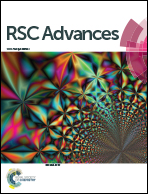A novel approach to the fabrication of bleached shellac by a totally chlorine-free (TCF) bleaching method
Abstract
This study made use of a novel totally chlorine-free (TCF) bleaching approach to prepare bleached shellac. Some single factor experiments were employed to investigate the effects of the main factors in the H2O2 bleaching method. A new chlorine-free bleached shellac resin was obtained in the Box–Behnken design responsive surface optimal experimental conditions (pH, 9.0–11.0; 1.33 mL g−1, concentration of 30% hydrogen peroxide; 2.0 h, dropping time of hydrogen peroxide; 7.2 h, bleaching time; 90 °C, temperature). The yield and color index of the bleached shellac obtained under the optimal experimental conditions were 80.84% and 0.5675 respectively. The result of the physicochemical property test, IR spectrum and DSC characterization indicate that the properties of H2O2 bleached shellac are similar to commercially refined shellac resin. Moreover, it is noteworthy that the H2O2 bleached shellac was remarkable in alcohol solubility and thermal lifetime tests. It had a higher acid value and a lower softening point compared with commercially refined shellac resin, which can be applied safely in many fields including food and medical industries without chlorine residues.


 Please wait while we load your content...
Please wait while we load your content...